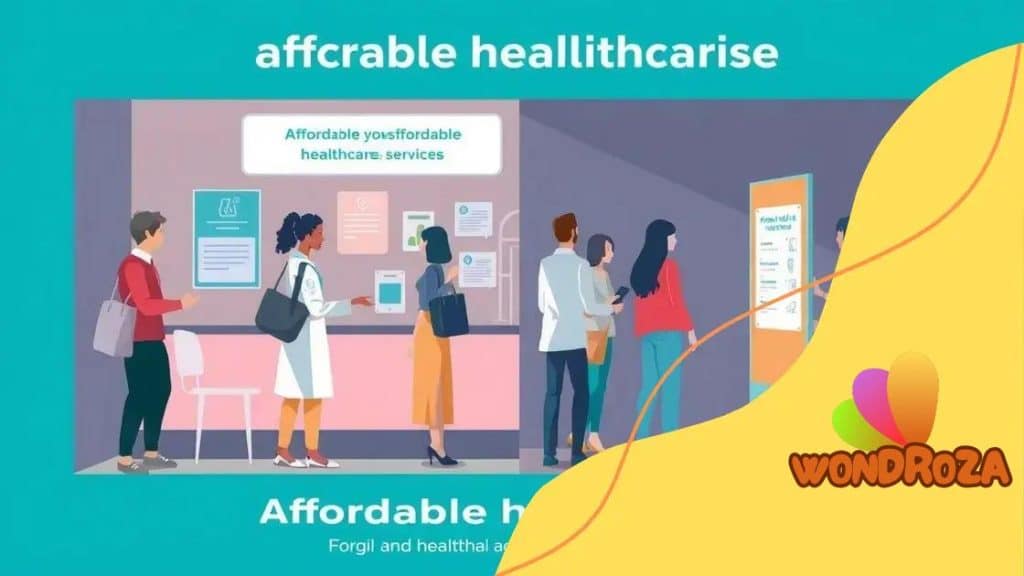Access to affordable healthcare through government subsidies

Access to affordable healthcare through government subsidies ensures that individuals and families can obtain necessary medical services, improving overall health outcomes and reducing financial burdens.
Access to affordable healthcare through government subsidies plays a vital role in ensuring that everyone receives necessary medical care. Have you ever wondered how these programs shape our healthcare landscape? Let’s dive into their significance.
Understanding government subsidies for healthcare
Understanding government subsidies for healthcare is essential for grasping how we can improve access to medical services. These programs help many individuals and families afford health insurance, ensuring that basic healthcare is a right, not a privilege.
What Are Healthcare Subsidies?
Healthcare subsidies are monetary assistance provided by the government to help lower the cost of health insurance. These subsidies aim to reduce out-of-pocket expenses for qualifying individuals based on criteria like income and family size. This support can alleviate the financial burden associated with medical care.
- Subsidies make premiums more affordable.
- They help lower deductibles and copayments.
- Eligibility is usually based on income levels.
- Some subsidies are tax credits applied during tax season.
When people can access affordable care, they are more likely to seek preventative services and necessary treatments. This creates a healthier population overall and reduces long-term healthcare costs. Understanding how these subsidies work can empower citizens to take advantage of available resources.
Types of Healthcare Subsidies
There are several types of government healthcare subsidies accessible in various programs. Some of the most common include:
- Premium tax credits: Financial aid that reduces monthly insurance premiums.
- Cost-sharing reductions: Help with out-of-pocket costs like deductibles and copayments for eligible individuals.
- Medicaid expansion: extends coverage to low-income adults in many states.
Each type is designed to target specific groups, ensuring that as many people as possible can benefit from these programs. Many don’t realize the extent of help available. As you explore these options, consider how they may apply to your situation.
Benefits of affordable healthcare access
Access to affordable healthcare brings numerous benefits to individuals and families, significantly improving quality of life. When people can afford their medical needs, they are more likely to seek regular check-ups and preventive care.
Improved Health Outcomes
Affordability leads to better health outcomes. Individuals with access to healthcare tend to manage chronic conditions effectively and prevent illnesses. This not only improves individual well-being but also reduces the overall strain on the healthcare system.
- Higher rates of preventive screenings.
- Lower hospital readmission rates.
- Increased vaccination coverage.
Furthermore, when healthcare is affordable, mental health also benefits. People often experience less anxiety about medical costs, allowing them to focus on their overall well-being.
Economic Benefits
Having affordable healthcare access can also lead to economic benefits for communities. Healthy individuals are more productive and can contribute more effectively to the workforce. This results in:
- Increased workplace productivity.
- Reduced absenteeism due to health issues.
- Lower healthcare costs for businesses.
In essence, when society invests in making healthcare affordable, the ripple effect leads to a healthier, more productive population. This investment pays off in various sectors, driving economic growth and stability.
Challenges in implementing healthcare subsidies

Implementing healthcare subsidies brings notable challenges that can affect their effectiveness. Understanding these obstacles is crucial to developing effective policies that enhance access.
Budget Constraints
One significant challenge is budget constraints faced by governments. Funding subsidies requires financial resources that may not always be available due to competing priorities. This can limit the reach and effectiveness of subsidy programs.
- Limited funding leads to fewer covered individuals.
- States may struggle to meet demand.
- Cost increases can impact other essential services.
As funds are allocated, decision-makers must carefully consider how to balance budgets while providing adequate healthcare access.
Complex Eligibility Criteria
Another hurdle is the complexity surrounding eligibility criteria for subsidies. Many people find it difficult to navigate the rules, and this confusion can prevent eligible individuals from applying.
- Misunderstandings about qualifications can lead to missed opportunities.
- Complicated application processes discourage enrollment.
- Lack of outreach can leave potential recipients unaware.
Clearer guidelines and educational resources are essential to simplify the process and help individuals understand their options better.
Administrative Challenges
Administrative issues can also impede the smooth implementation of healthcare subsidies. These challenges include:
- Inconsistent communication between agencies overseeing the subsidies.
- Difficulty in tracking and managing applications.
- Delays in processing claims, leading to frustration among applicants.
Addressing these administrative functions requires investment in systems and trained personnel to manage applications effectively, ensuring that individuals receive the help they need in a timely manner.
Case studies on successful subsidy programs
Examining case studies on successful subsidy programs provides valuable insights into how effective policies can improve healthcare access. These real-world examples highlight different strategies and outcomes across various regions.
Example 1: California’s Premium Assistance Program
The California Premium Assistance Program significantly increased the number of insured residents. By offering subsidies to low-income families, the state made health insurance more affordable. As a result, many families who struggled to pay premiums found relief.
- The state provided financial support to cover up to 70% of premiums.
- Enrollment increased by 25% within the first year of implementation.
- Overall health outcomes improved with increased access to preventive care.
This program demonstrates how targeted financial support can drive enrollment and improve public health.
Example 2: Medicaid Expansion in Kentucky
Kentucky’s Medicaid Expansion served another example of successful subsidy programs. By expanding Medicaid under the Affordable Care Act, the state offered coverage to individuals who previously fell into the coverage gap. This initiative had a transformative effect on healthcare availability within the state.
- Approximately 500,000 residents gained healthcare coverage.
- Emergency room visits decreased as patients sought preventive care.
- Job retention increased due to healthier workers.
This expansion highlights the impact of comprehensive policy changes in improving healthcare access for marginalized populations.
Example 3: Chile’s Health Insurance System
Chile’s mixed health insurance system provides another noteworthy model. In Chile, a combination of public and private options allows individuals to choose their providers while receiving subsidies for lower-income populations. This system promotes competition and ensures better service availability.
- Health insurance subsidies cover about 7 million Chileans.
- Patient satisfaction ratings have increased thanks to greater choice.
- Life expectancy has improved, reflecting better healthcare access.
These cases showcase how strategic implementation of subsidy programs can lead to successful outcomes in different contexts.
Future of healthcare with government support
The future of healthcare with government support looks promising as new strategies emerge to enhance access and affordability. The focus on improving healthcare systems can lead to healthier communities.
Innovative Technologies
As technology continues to evolve, integrating innovative solutions in healthcare will reshape how services are delivered. For instance, telemedicine has become more prevalent, allowing patients to consult with healthcare providers remotely. This approach has the potential to:
- Reach individuals in remote areas.
- Reduce waiting times for appointments.
- Provide immediate access to healthcare advice.
With government backing, telehealth initiatives can expand further, making it easier for people to receive timely care.
Expanded Coverage Options
Another trend in the future of healthcare is the expansion of coverage options. Government support can lead to more comprehensive plans that cater to diverse needs. These may include:
- More inclusive mental health services.
- Enhanced preventive care programs.
- Expansion of benefits for low-income families.
This expansion can bridge gaps in existing coverage, ensuring that everyone has access to necessary medical care.
Focus on Preventive Care
Shifting the emphasis to preventive care is a critical aspect of future healthcare plans. By investing in prevention, we can reduce the burden on emergency services and chronic disease management. Programs that encourage:
- Regular health screenings.
- Community health initiatives.
- Public health education campaigns.
These initiatives can lower long-term costs while improving individual health outcomes. When the government invests in preventive strategies, it aims to create a healthier population.
Collaboration Between Agencies
Future healthcare success will heavily depend on collaboration among various government agencies. A coordinated approach can streamline efforts to implement effective policies and programs. This would involve:
- Sharing data to identify health trends.
- Working together on community health projects.
- Aligning goals to maximize resource allocation.
By fostering teamwork among agencies, we can ensure that the healthcare system becomes more responsive to the needs of the population.
FAQ – Frequently Asked Questions about Healthcare Subsidies
What are healthcare subsidies?
Healthcare subsidies are financial assistance programs provided by the government to help individuals afford health insurance and medical services.
How do healthcare subsidies benefit low-income families?
Subsidies lower the overall cost of health insurance premiums, making it easier for low-income families to access necessary medical care.
What role does technology play in improving access to healthcare?
Technology, like telemedicine, allows patients to connect with healthcare providers remotely, increasing accessibility and reducing waiting times.
How can government support enhance preventive care?
Government support for preventive care programs encourages regular screenings and health education, which can lead to healthier communities and lower healthcare costs.





